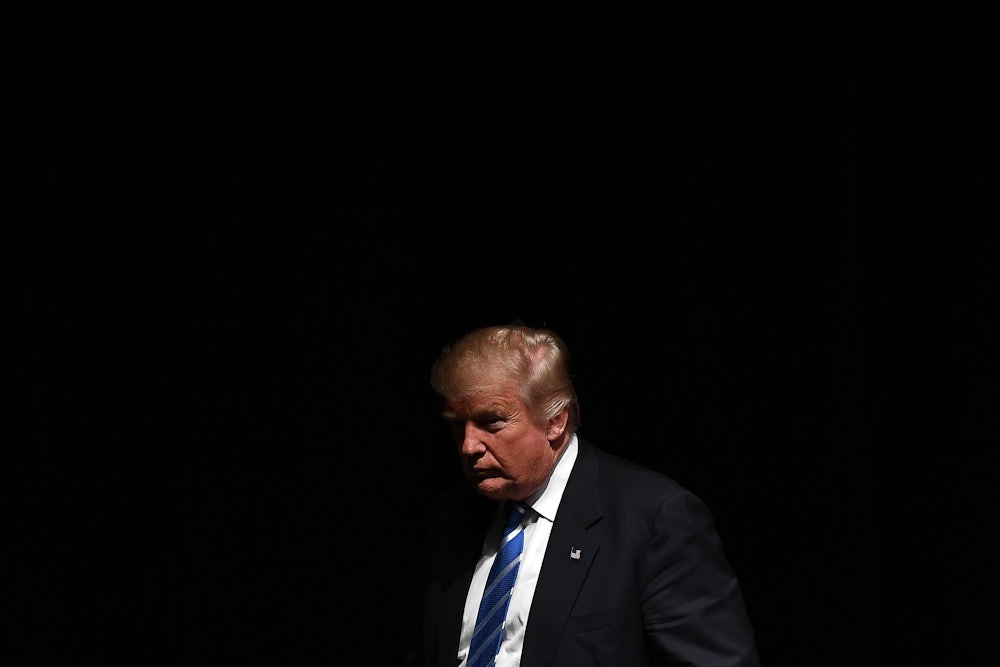At a rally in Iowa on Wednesday, Donald Trump tried to whip up the crowd by asking anyone who was a Christian conservative to raise their hand. The crowd cheered. The Republican nominee then made a strange follow-up request: “Raise your hand if you’re not a Christian conservative. I want to see this, right? Oh there’s a a couple people, that’s all right,” the candidate said as he brusquely waived his right hand. “I think we’ll keep them, right? Should we keep them in the room, yes? I think so.” He was in a jovial mood as he said all this, but if he was making a joke, it had a sinister undertone. Trump, after all, is running to be president of the pluralistic United States, but here he is suggesting that it might good to apply a religious test and to kick out anyone who wasn’t a Christian conservative. The remarks were a reminder of Tump’s notorious call to ban Muslims from entering the country, if not also of his Fox and Friends appearance on September 19 when he described Muslim immigrants as a “Trojan Horse” who were bringing a “cancer from within” to America.
Trump habitually sees the world in stark “us versus them” terms, and makes wholesale denunciations of entire ethnic groups. Which inevitably raises the question, “Is Donald Trump a fascist?”
An unresolved debate on that query has taken place since Trump launched his candidacy last summer. Writers like Adam Gopnik in The New Yorker and Robert Kagan in The Washington Post have answered “yes,” citing as evidence Trump’s ethnic demagoguery, his scorn for and ignorance of the existing democratic system, his indulgence in conspiracy thinking, and his open admiration of autocrats like Vladimir Putin. Other analysts, perhaps most compellingly Dylan Matthews in Vox, counter by noting that Trump’s movement differs from historical fascism in key ways: Trump has organized no paramilitary groups to subvert liberal norms, he hasn’t openly rejected democracy (although perhaps has tried to delegitimize the system by saying it is rigged), and he does not celebrate violence for the sake of violence (even though there is evident glee in his calls to beat up protesters and to torture enemy combatants).
But “is Donald Trump a fascist?” is not a yes/no question. Fascism has never been a fixed creed; it’s a syndrome, a series of intertwined tendencies.
One of the hallmarks of fascism is its opportunism, the willingness of fascist leaders to shift depending upon the needs of the moment. As the social theorist Franz Neumann noted in his 1944 book Behemoth, “National Socialism’s ideology is constantly shifting. It has certain magical beliefs—leadership adoration, supremacy of the master race—but [it] is not laid down in a series of categorical and dogmatic pronouncements.” Building on this insight, historian Robert Paxton argued in his 2004 book Anatomy of Fascism that “fascism does not rest explicitly upon an elaborated philosophical system, but rather upon popular feelings about master races, their unjust lot, and their rightful predominance over inferior people.”
Because fascism is so fluid, it’s possible to be fascistic without being a full-blown fascist. Trump’s fascistic tendencies are clear: He’s leading a racist mass movement based on palingenetic ultranationalism (in other words, the desire to restore a lost greatness) that is filled with contempt for liberal democratic norms. On the other hand, Trump’s differences with traditional fascism are also clear: He has no Trump Shirts beating up political enemies and he has so far refrained from calling for an overthrow of liberal democracy (however corrupt and rigged he might find it to be).
There’s also a demographic difference between Trump and traditional fascism. Nazism was a youth movement, dominated by an age cohort that shared the common experiences of the First World War and the economic crisis of the 1920s and 1930s. Average age of members tended to hover between the high twenties and the early thirties. As historian Herbert Ziegler argued in his 1989 book Nazi German’s New Aristocracy, “the Nazi party was much younger than one would expect considering the age distribution then prevalent in the population of the Reich.”
Trump voters, by contrast, tend to skew old. According to a Pew survey in July, the only age cohort where Trump led Clinton was 65+. Conversely, with those age 18-29, Clinton led by a two to one margin (60 percent to 30 percent). As they collect their pension checks and hone their retirement hobbies, Trumpkins lack the revolutionary élan of the goons who brought Mussolini and Hitler to power. Trump is an avatar of their anger and resentment but his movement lacks the shock troops necessary to truly roil (and possibly overthrow) society.
But even if Trump is only fascistic rather than a fascist, that’s more than scary enough. America has no precedent for how to defuse a fascistic movement. Even if Trump loses the election, the problem of what to do with his movement will remain. Hillary Clinton, if she wins, will have to figure out how to lower the temperature that Trump has raised, and how to reintegrate a fascistic mass movement into normal politics. And if she loses, we’ll get a definitive answer to the question everyone’s asking.
